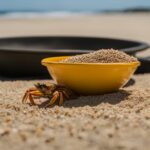Has your dog ever gotten into a little mischief and eaten something they shouldn’t have? It happens to the best of us, and recently, my dog devoured a pistachio shell! If you’re facing a similar situation, don’t panic. I’m here to guide you on what to do next.
Pistachios can be a delicious and nutritious snack for humans, but they can pose some risks to our furry friends. While the actual pistachio nut is generally safe for dogs in moderation, the shell can cause some health issues if ingested.
As a responsible pet owner, it’s important to be aware of the potential dangers and take appropriate action when necessary. In this article, I’ll provide you with valuable insights on how to handle the situation, signs of distress to watch out for, and when to seek veterinary care. Let’s jump right in!
Key Takeaways:
- Pistachio shells can be harmful to dogs if consumed in large quantities.
- Inducing vomiting is not recommended when a dog eats a pistachio shell due to the risk of injury.
- Monitor your dog for symptoms of distress or discomfort after ingesting pistachio shells.
- If your dog exhibits unusual behaviors or consumes a significant amount of pistachio shells, contact your veterinarian.
- Prevention is key – keep pistachio shells out of your dog’s reach and educate yourself on other foods that may be toxic to dogs.
Are Pistachio Shells Toxic for Dogs?
When it comes to dogs and pistachio shells, many pet owners wonder if they pose any toxicity risks. While pistachio shells are not inherently toxic to dogs, they can still be dangerous if consumed in large quantities. The main concern with pistachio shells lies in their potential to cause choking hazards and intestinal blockages.
To understand the dangers of dogs eating pistachio shells, it’s important to recognize their physical properties. Pistachio shells are hard and have sharp edges that can easily get lodged in a dog’s throat or gastrointestinal tract. This can lead to breathing difficulties, choking, and other serious health complications.
It’s crucial for pet owners to be mindful of the potential risks associated with dogs consuming pistachio shells. To keep your furry friend safe, make sure to store pistachios in sealed containers and dispose of the shells properly. Additionally, be cautious when eating pistachios around your dog, as accidental ingestion can occur. If you suspect that your dog has ingested a large amount of pistachio shells or is experiencing any discomfort, it’s best to seek veterinary care for a thorough evaluation and appropriate treatment.

Possible Hazards of Pistachio Shells for Dogs:
| Hazard | Potential Consequences |
|---|---|
| Choking | Pistachio shells can get lodged in the throat, obstructing the airway and causing breathing difficulties. |
| Intestinal Blockage | Ingesting a large quantity of pistachio shells can lead to blockages in the gastrointestinal tract, resulting in severe discomfort, vomiting, and potential need for surgery. |
By being proactive and taking precautions, you can minimize the risk of your dog consuming pistachio shells. Always prioritize your pet’s safety and well-being, and consult with a veterinarian for further guidance if you have any concerns.
Signs of Distress After Ingesting Pistachio Shells
When a dog ingests pistachio shells, it can lead to various signs of distress that may indicate potential health issues. It is important for dog owners to be aware of these symptoms and take appropriate action. Here are some common signs to watch out for:
- Difficulty Breathing: Dogs that have ingested pistachio shells may experience difficulty breathing or exhibit wheezing sounds. This could indicate an airway obstruction caused by the shells.
- Choking: If a dog is pawing at their mouth, coughing, or gagging, it could be a sign that a pistachio shell is stuck in their throat. Choking is a serious condition that requires immediate attention.
- Gastrointestinal Distress: Dogs may show signs of abdominal pain, vomiting, or diarrhea after consuming pistachio shells. This could be an indication of an intestinal blockage or irritation.
If you notice any of these signs or if your dog appears to be in distress after ingesting pistachio shells, it is important to seek veterinary care as soon as possible. The veterinarian will be able to assess the situation and provide the necessary treatment. Remember, early intervention is key to preventing further complications.
Ingesting pistachio shells can lead to serious health complications for dogs. It is crucial to be vigilant and take immediate action if your dog shows any signs of distress.
| Signs of Distress After Ingesting Pistachio Shells | |
|---|---|
| Difficulty Breathing | Pawing at mouth, wheezing sounds |
| Choking | Coughing, gagging |
| Gastrointestinal Distress | Abdominal pain, vomiting, diarrhea |
Remember, prevention is always the best approach when it comes to keeping your dog safe. Be sure to keep pistachio shells out of your dog’s reach and dispose of them properly. If you enjoy eating pistachios, make sure to clean up any shells immediately to minimize the risk of accidental ingestion. By being proactive and attentive to your dog’s well-being, you can help ensure they stay healthy and happy.
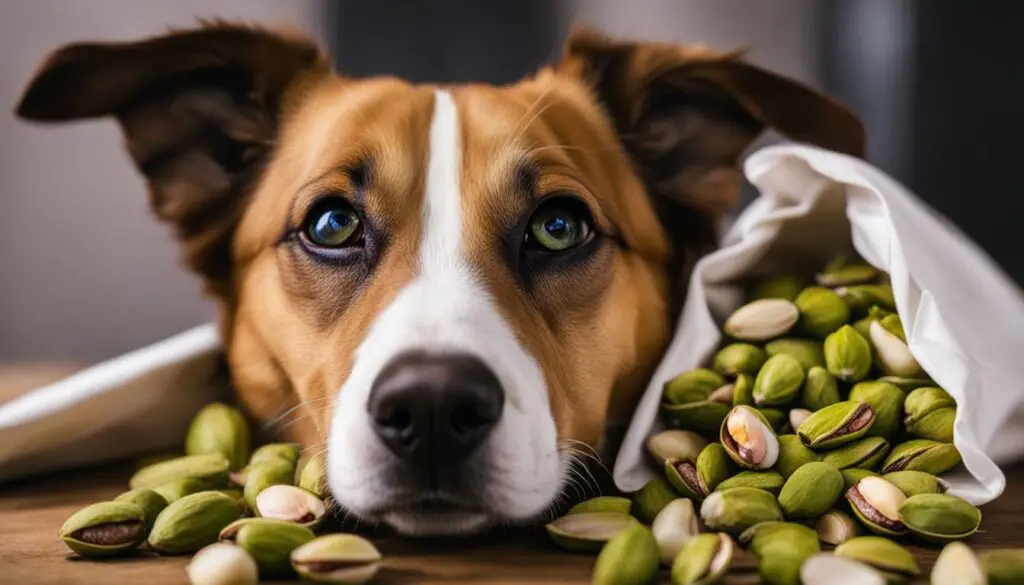
The Potential Dangers of Pistachio Shells
Consuming pistachio shells can pose various health risks to dogs. These dangers include choking hazards, dental issues, and gastrointestinal obstructions. The sharp edges of the shells can easily get lodged in a dog’s throat or gastrointestinal tract, causing discomfort and potential blockages.
In addition to the physical risks, pistachio shells can also harbor mold, which can be toxic to dogs. Ingesting pistachio shells contaminated with mold can lead to illness and other serious health complications. It is crucial to be aware of these potential dangers and take necessary precautions to protect your furry friend.
“The sharp edges of pistachio shells can easily get lodged in a dog’s throat or gastrointestinal tract, causing discomfort and potential blockages.”
The Effects of Pistachio Shells
When a dog ingests pistachio shells, the sharp edges can cause damage to their mouth, throat, and digestive system. This can result in pain, difficulty swallowing, and even internal injuries. It is important to monitor your dog’s behavior and seek veterinary care if they show any signs of distress after consuming pistachio shells.
Preventing Health Risks
To minimize the potential dangers of pistachio shells, it is best to prevent your dog from accessing them altogether. Keep pistachio shells out of their reach by storing them in sealed containers and disposing of them properly. Additionally, be mindful of where you eat pistachios and clean up any shells to prevent accidental ingestion by your dog.
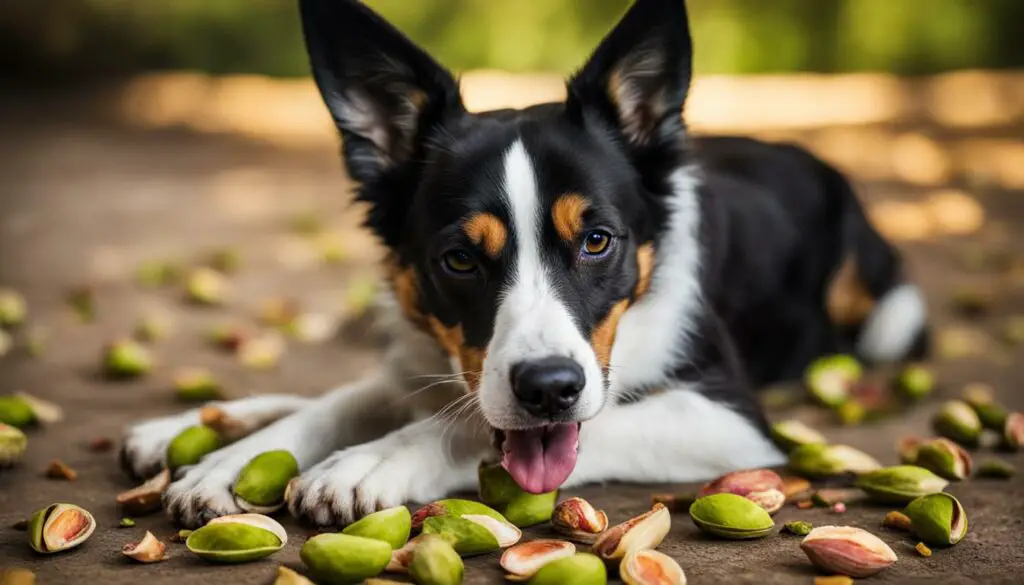
| Health Risks | Prevention |
|---|---|
| Choking hazards | Keep pistachio shells out of your dog’s reach |
| Dental issues | Avoid feeding foods that can damage your dog’s teeth |
| Gastrointestinal obstructions | Store pistachio shells in sealed containers |
| Mold toxicity | Dispose of pistachio shells properly |
What to Do if Your Dog Eats Pistachio Shells
If your dog ingests pistachio shells, it is important to stay calm and take the appropriate steps to ensure their safety and well-being. Here are some guidelines on what to do if your dog eats pistachio shells:
- Monitor their behavior: Keep an eye on your dog for any signs of distress or discomfort. Watch for symptoms such as vomiting, diarrhea, abdominal pain, or difficulty breathing. If your dog shows any unusual behavior, contact your veterinarian for further guidance.
- Do not induce vomiting: Unlike some other food ingestions, inducing vomiting is not recommended when it comes to pistachio shell ingestion. The sharp edges of the shells can cause damage to the throat and gastrointestinal tract, making vomiting potentially harmful. It is best to seek professional advice before attempting any home remedies.
- Contact your veterinarian: If your dog has consumed a large amount of pistachio shells or is showing concerning symptoms, it is important to contact your veterinarian. They can provide personalized advice based on your dog’s specific situation and may recommend a visit for a thorough examination.
Remember that prevention is always better than cure, so it is crucial to keep pistachio shells and other potentially harmful foods out of your dog’s reach. By being proactive and taking the appropriate precautions, you can help ensure the well-being of your furry friend.
| Table: What to Do if Your Dog Eats Pistachio Shells | |
|---|---|
| Step | Action |
| 1 | Monitor your dog’s behavior for any signs of distress or discomfort. |
| 2 | Do not induce vomiting; seek professional advice before attempting any home remedies. |
| 3 | Contact your veterinarian if your dog has consumed a large amount of pistachio shells or is showing concerning symptoms. |
By following these steps and seeking appropriate veterinary care when needed, you can help ensure the health and well-being of your dog in the event they ingest pistachio shells.

Veterinary Advice for Dogs Ingesting Pistachio Shells
If your dog has ingested pistachio shells, it is important to take appropriate action to ensure their well-being. While pistachio shells are not inherently toxic to dogs, they can pose various health risks, including choking hazards and gastrointestinal obstructions. To determine if your dog requires veterinary care, it is essential to closely monitor their behavior and look out for any signs of distress.
If your dog exhibits symptoms such as difficulty breathing, choking, or pawing at their mouth after ingesting pistachio shells, it is crucial to seek immediate veterinary advice. These symptoms may indicate an airway obstruction or gastrointestinal blockage, which can be potentially life-threatening if not addressed promptly.
Additionally, if your dog has consumed a large quantity of pistachio shells, it is advisable to consult a veterinarian. They can assess the situation and provide guidance based on your dog’s specific circumstances. A veterinarian may recommend monitoring your dog closely at home, administering home remedies to aid digestion, or in some cases, performing medical procedures to remove the obstructive material.
Remember, while it is important to be cautious and seek veterinary advice when necessary, prevention is key. Keep pistachio shells out of your dog’s reach by properly disposing of them and storing them in sealed containers. By taking these precautions and being proactive in ensuring your dog’s safety, you can help prevent potential health risks associated with pistachio shell ingestion.
| Veterinary Advice for Dogs Ingesting Pistachio Shells |
|---|
| Symptoms to Watch Out For: |
| – Difficulty breathing |
| – Choking |
| – Pawing at the mouth |
| When to Seek Veterinary Care: |
| – Signs of distress |
| – Ingestion of a large quantity of pistachio shells |
| Prevention Tips: |
| – Properly dispose of pistachio shells |
| – Store pistachio shells in sealed containers |
“It is crucial to seek veterinary care if your dog shows signs of distress or has consumed a large amount of pistachio shells.”
Preventing Dogs from Eating Pistachio Shells
Dogs are curious creatures and can sometimes get their paws on things they shouldn’t eat. It’s important to take proactive measures to prevent your furry friend from consuming pistachio shells, which can pose potential health risks. By following these simple tips, you can keep your dog safe and avoid any unwanted trips to the veterinarian.
Keep Pistachio Shells Out of Reach
One of the easiest ways to prevent dogs from eating pistachio shells is to ensure they cannot access them. Store pistachio shells in sealed containers and place them in areas where your dog cannot reach, such as high shelves or locked cabinets. Additionally, always clean up any pistachio shells that may have fallen on the floor or in your yard to eliminate any opportunities for your dog to find and snack on them.
Provide Safe and Healthy Alternatives
If your dog has a penchant for snacking on crunchy treats, it’s important to provide them with safe and healthy alternatives to satisfy their chewing desires. Consider offering chew toys specially designed for dogs or crunchy dog-friendly snacks that are free from any potential hazards. This way, your dog can indulge their natural chewing instincts without the risk of consuming harmful pistachio shells.
| Preventive Measures | Benefits |
|---|---|
| Store pistachio shells in sealed containers | Prevents dogs from accessing and consuming the shells |
| Clean up pistachio shells promptly | Eliminates any opportunities for dogs to find and eat them |
| Provide safe and healthy alternatives | Satisfies dogs’ chewing instincts without risk |
Train Your Dog to “Leave It”
Teaching your dog the “leave it” command can be a lifesaver when it comes to preventing them from eating dangerous substances like pistachio shells. Start by showing your dog a treat in your closed fist and saying “leave it.” Once they lose interest in your closed fist, reward them with a different treat. Practice this command regularly, gradually introducing pistachio shells as the object to be ignored. With consistent training, your dog will learn to avoid pistachio shells altogether.
By implementing these preventative measures, you can keep your dog safe and free from the potential dangers of consuming pistachio shells. Remember, being proactive is key in ensuring the well-being of your furry friend.
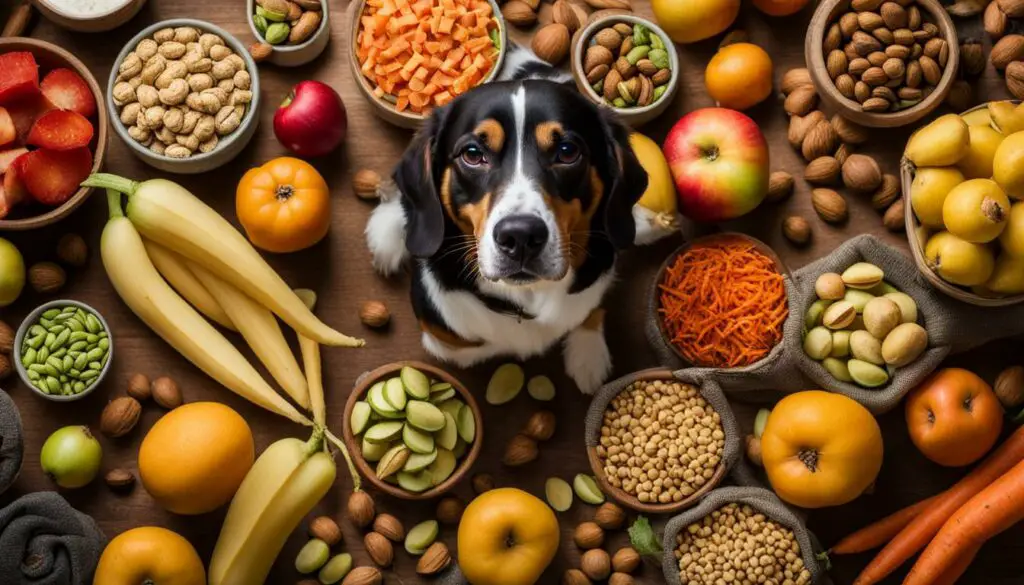
Other Foods Toxic to Dogs
While pistachio shells can be harmful to dogs if ingested in large quantities, there are also other foods that can be toxic to our furry friends. It’s important to be aware of these foods and avoid feeding them to our dogs to ensure their well-being. Here are some other common foods that can be harmful to dogs:
| Foods | Potential Risks |
|---|---|
| Chocolate | Contains theobromine and caffeine, which can cause heart issues, increased heart rate, and seizures in dogs. |
| Onions and Garlic | Contain substances that can damage a dog’s red blood cells and lead to anemia. |
| Grapes | Can cause kidney failure in dogs, leading to symptoms such as vomiting, diarrhea, and lethargy. |
| Xylitol | An artificial sweetener found in gum, candy, and some peanut butters, which can be toxic to dogs and cause a sudden drop in blood sugar levels. |
These are just a few examples of foods that can be harmful to dogs. It’s important to familiarize ourselves with the potential risks associated with certain foods and take precautions to keep them out of our furry friends’ reach.
What to do if your dog ingests a toxic food?
If your dog ingests a toxic food, it’s crucial to take immediate action. Here are some steps you can follow:
- Stay calm: It’s important to stay calm and assess the situation.
- Contact your veterinarian: Reach out to your veterinarian for guidance and inform them about the situation.
- Follow their advice: Your veterinarian may instruct you to induce vomiting or bring your dog in for further examination and treatment.
- Monitor your dog: Keep a close eye on your dog’s behavior and look out for any signs of distress or discomfort.
Remember, prevention is key when it comes to our dogs’ health. By being aware of the potential dangers and avoiding feeding our dogs harmful foods, we can help keep them safe and healthy.
Pancreatitis in Dogs
Pancreatitis is a condition that can occur in dogs as a result of consuming high-fat foods, such as pistachio shells. It is important for dog owners to be aware of this potential risk and take necessary precautions to prevent pancreatitis from developing.
When a dog consumes a large amount of fat, the pancreas can become inflamed, leading to pancreatitis. This inflammation can cause a range of symptoms, including vomiting, diarrhea, loss of appetite, and abdominal pain. If left untreated, pancreatitis can be a serious and potentially life-threatening condition.
Seeking veterinary care is crucial if you suspect your dog has developed pancreatitis. A veterinarian can conduct a thorough examination, which may include blood tests and imaging, to confirm the diagnosis. Treatment for pancreatitis in dogs typically involves supportive care, such as fluid therapy, pain management, and a low-fat diet. In severe cases, hospitalization may be necessary.
| Symptoms of Pancreatitis in Dogs | Treatment for Dogs that Ate Pistachio Shells |
|---|---|
|
|
Preventing pancreatitis in dogs involves being mindful of their diet and avoiding foods that are high in fat, including pistachio shells. It is essential to read food labels and consult with a veterinarian to determine the appropriate diet for your dog’s specific needs. By providing a balanced and nutritious diet, you can help reduce the risk of pancreatitis and promote your dog’s overall health and well-being.
“Pancreatitis can be a serious condition for dogs, and it’s important to be cautious about the foods they consume. High-fat foods, such as pistachio shells, can trigger pancreatitis in dogs. It’s always better to be safe than sorry and avoid feeding your furry friend foods that may lead to this painful condition.” – Dr. Emily Thompson, DVM
Aflatoxin Poisoning
If your dog has consumed pistachio shells, it is essential to be aware of the potential risk of aflatoxin poisoning. Aflatoxin is a toxic substance produced by mold that can grow on pistachio shells. Ingesting pistachio shells contaminated with aflatoxin can lead to severe poisoning in dogs.
Symptoms of aflatoxin poisoning may include vomiting, fever, jaundice (yellowing of the skin and eyes), and lethargy. These signs indicate that your dog’s health is in immediate danger and requires prompt veterinary care.
If you suspect that your dog has consumed pistachio shells contaminated with aflatoxin, do not hesitate to seek emergency veterinary care. Your veterinarian will be able to provide the necessary treatment and support to help your dog recover.
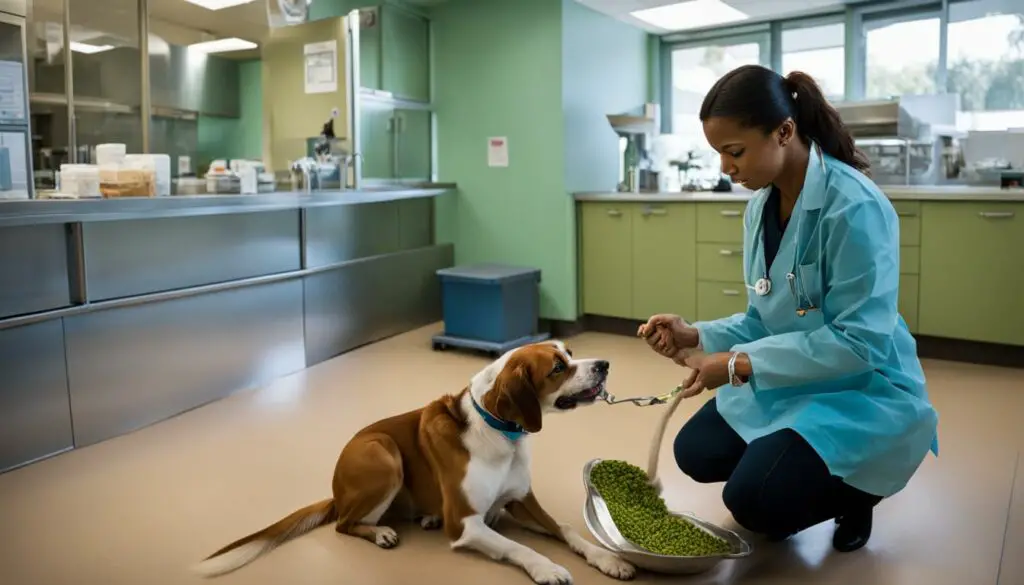
Possible Treatment for Aflatoxin Poisoning
The treatment for aflatoxin poisoning in dogs may involve the administration of activated charcoal to absorb the toxins and prevent further absorption into the bloodstream. Your veterinarian may also provide supportive care, such as intravenous fluids, to manage dehydration and flush out the toxins from your dog’s system.
It is important to note that the prognosis for dogs with aflatoxin poisoning can vary depending on the severity of the poisoning and the timeliness of treatment. Early intervention and prompt veterinary care are crucial for the best possible outcome.
| Symptoms of Aflatoxin Poisoning | Emergency Actions |
|---|---|
| Vomiting | Contact a veterinarian immediately |
| Fever | Seek urgent veterinary care |
| Jaundice | Bring your dog to the nearest animal hospital |
| Lethargy | Do not delay in getting veterinary assistance |
Remember, prevention is the best way to protect your dog from aflatoxin poisoning. Keep pistachio shells and other potentially contaminated foods out of your dog’s reach, and always monitor their environment to ensure their safety.
Dental Issues from Pistachio Shells
When it comes to dogs consuming pistachio shells, dental issues can be a significant concern. The sharp edges of the shells can cause damage to their teeth and gums, leading to pain and discomfort. Dogs may experience broken teeth or gum injuries if the sharp edges of the shells get lodged between their teeth or underneath their gums.
To ensure your dog’s dental health, it is essential to provide proper dental care and avoid feeding them foods that can damage their teeth, such as pistachio shells. Regular brushing of their teeth, providing dental chews, and scheduling professional dental cleanings can help prevent and address dental issues. If you notice any signs of dental problems, such as bad breath, difficulty eating, or swollen gums, it is crucial to consult with a veterinarian for a thorough evaluation and appropriate treatment.
“The sharp edges of pistachio shells can cause dental issues in dogs, including broken teeth and gum injuries. It is important to provide proper dental care and avoid feeding them foods that can damage their teeth.”
Dental Care Tips for Dogs:
- Brush your dog’s teeth regularly with a pet-safe toothbrush and toothpaste.
- Provide dental chews or toys that promote dental health and help remove plaque and tartar.
- Schedule regular professional dental cleanings for your dog.
- Monitor your dog’s oral health and seek veterinary advice if you notice any dental issues.
By prioritizing your dog’s dental health and avoiding foods that can harm their teeth, you can ensure their overall well-being and prevent dental problems associated with consuming pistachio shells or other inappropriate items.
| Dental Issue | Prevention Tips |
|---|---|
| Broken Teeth | Avoid feeding your dog hard items like pistachio shells. Provide appropriate dental chews instead. |
| Gum Injuries | Remove sharp-edged items like pistachio shells from your dog’s reach. Regular dental care can also help prevent gum injuries. |
| Plaque and Tartar Build-up | Regular teeth brushing and dental cleanings can help prevent the build-up of plaque and tartar. |
Feeding Pistachios to Dogs
Pistachios can be a tempting snack for both humans and dogs, but it is important to be cautious when feeding them to your furry friend. While pistachios themselves are not toxic to dogs, there are potential risks associated with their consumption. It is crucial to ensure that pistachios are prepared and served in a manner that is safe for your canine companion.
Pistachios should always be unsalted, as the high sodium content in salted pistachios can be harmful to dogs. Additionally, it is essential to remove the shells before feeding pistachios to your dog. The hard shells can pose a choking hazard and may cause gastrointestinal blockages if ingested. Therefore, it is best to offer your dog shelled pistachios or to remove the shells yourself before sharing this treat.
When introducing pistachios into your dog’s diet, it is important to do so in moderation. Pistachios are high in fat and can contribute to weight gain and potential health issues such as pancreatitis if consumed in excess. As with any new food, it is advisable to start with small quantities and monitor your dog for any adverse reactions or digestive upset. If your dog shows any signs of discomfort or displays unusual symptoms after consuming pistachios, it is recommended to consult with a veterinarian for guidance.
The Benefits of Alternative Treats
While pistachios can be an occasional treat for your dog, there are other healthier alternatives that can provide similar nutritional benefits without the potential risks. Consider incorporating fruits and vegetables into your dog’s diet as safe and nutritious alternatives to pistachios. Some examples include blueberries, strawberries, carrots, and green beans. These treats are low in calories, rich in vitamins and minerals, and can be a great source of hydration for your canine companion.
In summary, while pistachios can be enjoyed by dogs in moderation, it is important to take precautions to ensure their safety. Feeding unsalted, shelled pistachios and monitoring your dog’s reaction to this treat are essential steps to prevent any potential health issues. As always, consulting with a veterinarian regarding your dog’s specific dietary needs and any concerns you may have is highly recommended.
Other Foods to Avoid Feeding Dogs
While pistachio shells can pose health risks to dogs, there are other foods that should also be avoided in their diet. It’s important to be aware of these foods to ensure the well-being of your furry friend.
1. Chocolate:
Chocolate contains theobromine, which can be toxic to dogs. Even a small amount of chocolate can cause symptoms such as vomiting, diarrhea, rapid breathing, or even seizures. Dark chocolate and unsweetened baking chocolate are particularly dangerous due to their high levels of theobromine. It’s best to keep all chocolate products out of reach of your dog.
2. Grapes and Raisins:
Grapes and raisins can lead to kidney failure in dogs. The exact substance in grapes and raisins that is toxic to dogs is unknown, but even a small amount can cause vomiting, diarrhea, and lethargy. It’s best to avoid feeding grapes and raisins to your dog and keep them out of their reach.
3. Onions and Garlic:
Onions and garlic can cause damage to a dog’s red blood cells, leading to anemia. Symptoms may include weakness, pale gums, and loss of appetite. It’s important to avoid feeding any foods containing onions or garlic, such as certain seasonings or sauces, to your dog.
4. Alcohol:
Alcohol is highly toxic to dogs, even in small amounts. It can cause dangerous drops in blood sugar, blood pressure, and body temperature. Symptoms of alcohol poisoning in dogs may include vomiting, difficulty breathing, seizures, and even coma. It’s essential to keep all alcoholic beverages out of your dog’s reach.
Remember, it’s always best to consult with a veterinarian before introducing new foods into your dog’s diet. By being aware of and avoiding these dangerous foods, you can help keep your dog happy, healthy, and safe.
| Foods to Avoid | Potential Risks |
|---|---|
| Chocolate | Theobromine toxicity, vomiting, diarrhea, seizures |
| Grapes and Raisins | Kidney failure, vomiting, diarrhea, lethargy |
| Onions and Garlic | Anemia, weakness, pale gums, loss of appetite |
| Alcohol | Blood sugar drops, difficulty breathing, seizures, coma |
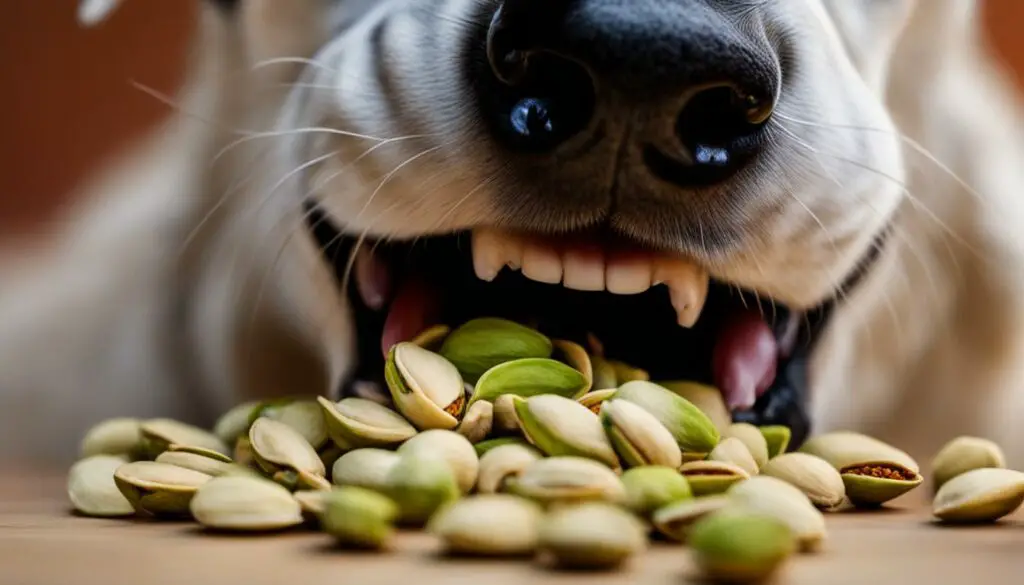
Conclusion
In conclusion, if your dog has consumed a pistachio shell, it is important to take the necessary precautions to ensure their safety and well-being. While pistachios themselves are not toxic to dogs, the shells can pose various health risks. Choking hazards, dental issues, and gastrointestinal blockages are some of the potential dangers associated with dogs ingesting pistachio shells.
To prevent dogs from eating pistachio shells, it is crucial to keep them out of reach. Store pistachio shells in sealed containers and dispose of them properly. It is also important to be aware of other foods that can be harmful to dogs, such as chocolate, onions, and grapes. By educating yourself on what foods to avoid and maintaining a safe eating environment for your dog, you can minimize the risks.
If your dog does consume pistachio shells and shows signs of distress, it is recommended to seek veterinary care. A veterinarian can assess the situation and provide appropriate guidance and treatment if necessary. Remember, early intervention is key in preventing serious complications and ensuring your dog’s health.
Your dog’s well-being is of utmost importance, so always be vigilant and proactive in keeping them safe. By properly managing their diet and environment, you can help prevent incidents of dogs ingesting pistachio shells and ensure a healthier and happier life for your furry friend.
FAQ
Are pistachio shells toxic for dogs?
No, pistachio shells are not toxic to dogs. However, they can pose choking hazards and cause intestinal blockages.
What are the signs of distress after ingesting pistachio shells?
Dogs may exhibit difficulty breathing, choking, or pawing at their mouth if they have ingested pistachio shells. These symptoms may indicate an obstruction in the airways or gastrointestinal tract.
What should I do if my dog eats pistachio shells?
Stay calm and monitor your dog’s behavior. Do not induce vomiting, as this can cause further harm. Contact your veterinarian for guidance if your dog displays signs of distress or has consumed a large amount of pistachio shells.
When should I seek veterinary care for my dog after ingesting pistachio shells?
It is advisable to consult a veterinarian if your dog shows signs of discomfort, exhibits unusual symptoms, or has consumed a significant amount of pistachio shells.
How can I prevent my dog from eating pistachio shells?
Keep pistachio shells out of your dog’s reach by storing them in sealed containers and properly disposing of them after consumption. Clean up any shells to prevent accidental ingestion.
What are other foods I should avoid feeding my dog?
Chocolate, coffee, onions, garlic, alcohol, grapes, and bones are all foods that can be harmful to dogs and should be kept out of their reach.
Can pistachio shells cause dental issues in dogs?
Yes, the sharp edges of pistachio shells can cause dental problems such as broken teeth or gum injuries if they get lodged between the teeth or underneath the gums.
Can I feed pistachios to my dog?
It is generally safe to feed pistachios to dogs in moderation and without the shells. However, it is important to consult with a veterinarian before introducing new foods to your dog’s diet.
What is pancreatitis in dogs?
Pancreatitis is a condition that can be triggered by the consumption of high-fat foods, such as pistachio shells. It is characterized by inflammation of the pancreas and can cause symptoms such as vomiting, fever, and abdominal pain.
What is aflatoxin poisoning?
Aflatoxin is a toxic substance produced by mold that can grow on pistachio shells. Ingesting pistachio shells contaminated with aflatoxin can lead to poisoning in dogs, causing symptoms such as vomiting, fever, jaundice, and lethargy.
What should I do if my dog has dental issues from pistachio shells?
Provide proper dental care for your dog and consult with a veterinarian for treatment options. Avoid feeding foods that can damage their teeth, including pistachio shells.
What should I do if my dog eats a large quantity of pistachio shells?
Contact your veterinarian for advice. They will be able to assess the situation and determine the appropriate course of action for your dog’s well-being.
What are other foods I should avoid feeding my dog?
In addition to pistachio shells, foods such as chocolate, coffee, onions, garlic, alcohol, grapes, and bones should be avoided when feeding dogs.


